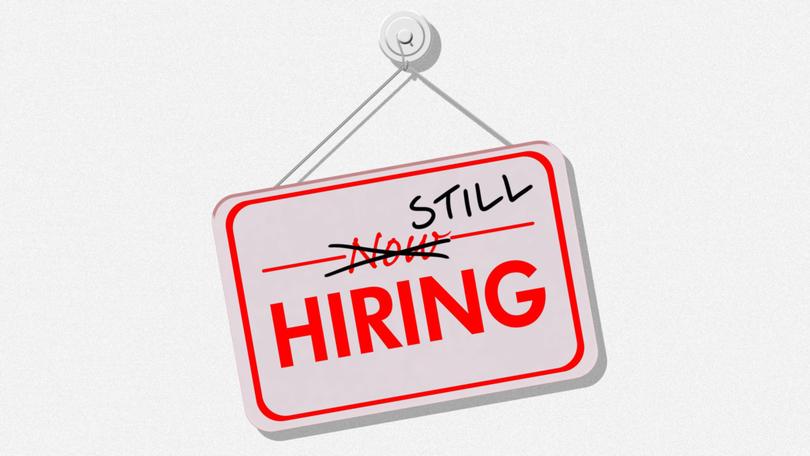JACKSON HEWETT: Interest rate cuts hope fade as immigration, public service drive jobs numbers

Today’s surprise fall in the unemployment rate will likely dampen any nascent hopes for an interest rate cut in February.
On Tuesday, Reserve Bank chief Michele Bullock warned despite the slowdown in growth the economy was still too hot to risk cutting rates and driving up inflation. NAB’s business survey found a similar phenomenon — firms were operating at near full capacity to trying to keep up with demand.
A fall in the seasonally adjusted unemployment rate by 0.2 per cent to 3.9 per cent has confirmed that picture. Anyone who wants a job can find one — in fact, pretty much anyone able to work is. The participation rate is a fraction below its all-time high and still 1.5 per cent higher than before the pandemic.
Sign up to The Nightly's newsletters.
Get the first look at the digital newspaper, curated daily stories and breaking headlines delivered to your inbox.
By continuing you agree to our Terms and Privacy Policy.Employment is powering ahead on two cylinders, population driven growth and the expansion of the public service.
“Recent growth in population has boosted the labour supply as employment has kept up with population growth,” said David Taylor, head of the ABS’s labour statistics.
Big government spending is the other driver, with health sector now the highest employer in the country.
Labour account data released by the ABS last week shows 2.6 million people now work in healthcare and social assistance, after numbers grew by 300,000 workers, or 11.4 per cent in a year.
Public administration and safety grew by 10 per cent this year.
Education and training grew 3 per cent.
While jobs in those sectors grew over the year, the discretionary economy went backwards.
Accommodation and hospitality cut staff by 12 per cent.
Wholesale trade fell 4 per cent.
Arts and recreation cut 6 per cent of the workforce.
Information media and telecommunications went backwards 7.4 per cent. Some of that was a factor of technological change, but likely a large part was an advertising recession caused by a reduction in marketing budgets.
But the labour accounts data show things weren’t all bad.
White collar jobs in finance, professional and scientific services, and admin all grew. Construction jobs were relatively strong, as was mining, agriculture and retail.
Australia may be in a per capita recession, but the pain is not being felt across the board. Those feeling it most are renters and mortgage holders.
Commbank’s Black Friday spending figures showed those groups spent a little more than last year but not by much. Renters spent just 0.4 per cent more, while mortgage-holders spent 1.6 per cent more.
Those who owned their own homes outright, grew spending by 2.7 per cent.
Mortgage data from APRA, also out today, tells a similar picture. While dwelling prices are easing, those with money are buying. Mortgage credit growth went up by around 5 per cent for both owner occupiers and investors in the September quarter to grow 10 per cent overall for the month. Loans up to 90 days past due hardly changed.
In the near term, for mortgage holders hoping for interest rate relief, the picture has worsened. Bond markets, which were starting to move their bets to February, have pushed those bets back out.
And while economists leapt on a “change of language” in the last Reserve Bank rates communique, governor Michele Bullock and her deputy Andrew Hauser have been at pains to say the journey to post-pandemic equilibrium is unfolding just as expected.
If things continue on this path, the Reserve Bank looks to have met its mandate spectacularly well. Inflation is moderating in line with expectations, while workers are still employed.
“The ongoing strength in the Australian job market means that the RBA can fully commit to achieving their inflation target without needing to worry about the job market unravelling,” said Callam Pickering, chief economist of employment website Indeed.com.
“Employment continues to surge higher, driven by strong job creation across most sectors.”
Deloitte’s biannual survey of chief financial officers released before today’s job data also suggests a rosier picture than the recent GDP figures suggest. The people in charge of company budgets are more optimistic than they have been in two years, with confidence surging 12 per cent compared to six months ago.
More than two-thirds of CFOs are now confident about business prospects and the threat of an economic downturn has dropped from their number one concern to fifth place.
Reflecting the surprisingly robust jobs data, finding and securing key talent is now the second biggest issue for CFOs, with strategy execution the number one risk.
“Australian CFOs clearly sense we’re switching to a recovery phase, so their focus is shifting inward, with inability to execute strategies and securing and retaining key talent now top of mind,” Deloitte Access Economics Partner David Rumbens said.
Deloitte said that confidence partly relies on inflation coming down enough on to trigger a rate cut that would generate stronger consumer spending and business investment. Today’s strong job figures may dampen that enthusiasm but the positive trend is clear.
Today’s jobs figures will have economists scratching their heads about whether the economy is experiencing a structural shift where growth, inflation and the natural rate of unemployment need to be recalibrated.
It will also trigger fresh concerns the composition of the economy is too heavily weighted to public sector jobs.
While Labor’s spending is clearly driving the public sector higher, it is the continuation of a 15-year trend. From 1994 to the GFC, public and private sector jobs were growing in line but from the 2008 onwards that gap has been increasingly widening.
It reflects the demographic shift of an ageing population, which is not unique to Australia, and the turbo boost of the NDIS, which is.
But the ABS also reveals a 30-year timeline of a country riding off the mining industry’s back.
Mining jobs are up three fold, while real estate agents have doubled.
For those who lament the fact we “don’t make things any more”, I have bad news for you.
The biggest change in the workforce looks to be the paper pushers. Administrative and support services jobs grew 272 per cent, while professional service and technical jobs grew 221 per cent.
By contrast manufacturing and agricultural jobs have gone backwards.
Health care and social assistance jobs grew by 254 per cent, which suggests we need to update the lament of the last three decades.
We dig things out of the ground, sell houses to each other and look after the elderly and infirm.
With the digging things up part not going so well, the question is, who is going to pay the bills?

